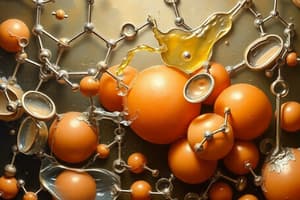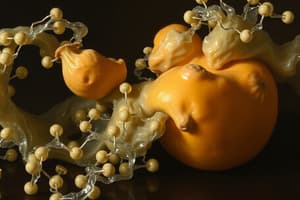Podcast
Questions and Answers
What triggers the formation of ketone bodies during starvation?
What triggers the formation of ketone bodies during starvation?
- High levels of insulin
- Excessive glucose production
- Increased fatty acid β-oxidation (correct)
- Depletion of TCA cycle intermediates (correct)
Which of the following is NOT a ketone body?
Which of the following is NOT a ketone body?
- Butyrate (correct)
- β-Hydroxybutyrate
- Acetoacetate
- Acetone
Under what conditions are ketone bodies utilized in non-hepatic tissues?
Under what conditions are ketone bodies utilized in non-hepatic tissues?
- When glucose supply is abundant
- Only during physical exercise
- Under starvation conditions (correct)
- During protein synthesis
What is the primary role of succinate produced in the glyoxylate cycle of plant seeds?
What is the primary role of succinate produced in the glyoxylate cycle of plant seeds?
Which statement about the glyoxylate cycle is true?
Which statement about the glyoxylate cycle is true?
What is the main advantage of fatty acid catabolism as an energy source?
What is the main advantage of fatty acid catabolism as an energy source?
What is the role of acyl-CoA synthetase in fatty acid metabolism?
What is the role of acyl-CoA synthetase in fatty acid metabolism?
During the β-oxidation of palmitic acid, how much ATP is generated from each cycle?
During the β-oxidation of palmitic acid, how much ATP is generated from each cycle?
How many cycles of β-oxidation are required to fully oxidize palmitic acid?
How many cycles of β-oxidation are required to fully oxidize palmitic acid?
What is the ultimate yield of ATP from the complete oxidation of one molecule of palmitic acid?
What is the ultimate yield of ATP from the complete oxidation of one molecule of palmitic acid?
Which component is necessary for the transport of fatty acyl-CoA into the mitochondria?
Which component is necessary for the transport of fatty acyl-CoA into the mitochondria?
What happens to the β-oxidation cycle after the last step of thiolysis?
What happens to the β-oxidation cycle after the last step of thiolysis?
Which type of fatty acids require additional steps for oxidation compared to saturated fatty acids?
Which type of fatty acids require additional steps for oxidation compared to saturated fatty acids?
What is formed as a result of complete β-oxidation of saturated fatty acids?
What is formed as a result of complete β-oxidation of saturated fatty acids?
How do plants differ from humans in relation to fatty acid metabolism?
How do plants differ from humans in relation to fatty acid metabolism?
What is the net ATP yield from the complete oxidation of one glucose molecule?
What is the net ATP yield from the complete oxidation of one glucose molecule?
How many ATP are generated from one cycle of β-oxidation?
How many ATP are generated from one cycle of β-oxidation?
Which of the following statements is true regarding ATP generation from fatty acid oxidation compared to glucose oxidation?
Which of the following statements is true regarding ATP generation from fatty acid oxidation compared to glucose oxidation?
What is the ATP equivalent of hydrolyzing one ATP molecule to AMP and 2 Pi?
What is the ATP equivalent of hydrolyzing one ATP molecule to AMP and 2 Pi?
Which additional enzyme is required for the oxidation of monounsaturated fatty acids?
Which additional enzyme is required for the oxidation of monounsaturated fatty acids?
For each acetyl-CoA that enters the TCA cycle, how many ATP equivalents are generated?
For each acetyl-CoA that enters the TCA cycle, how many ATP equivalents are generated?
What is the total ATP yield from the complete oxidation of a C18 saturated fatty acid?
What is the total ATP yield from the complete oxidation of a C18 saturated fatty acid?
In the oxidation of polyunsaturated fatty acids, how many additional enzymes are required?
In the oxidation of polyunsaturated fatty acids, how many additional enzymes are required?
Which step is skipped during the first cycle of β-oxidation for unsaturated fatty acids?
Which step is skipped during the first cycle of β-oxidation for unsaturated fatty acids?
What type of fatty acids are characterized by having an odd number of carbon atoms?
What type of fatty acids are characterized by having an odd number of carbon atoms?
What is the total production of ATP from oxidation of 2 pyruvate to 2 acetyl-CoA?
What is the total production of ATP from oxidation of 2 pyruvate to 2 acetyl-CoA?
What happens to the propionyl-CoA produced during the oxidation of odd-chain fatty acids?
What happens to the propionyl-CoA produced during the oxidation of odd-chain fatty acids?
What is the energy equivalent of hydrolyzing PPi to 2Pi?
What is the energy equivalent of hydrolyzing PPi to 2Pi?
Which of the following fatty acid oxidation pathways results in the highest ATP yield?
Which of the following fatty acid oxidation pathways results in the highest ATP yield?
Flashcards
Ketone body formation
Ketone body formation
During starvation, the liver creates ketone bodies from excess acetyl-CoA, a byproduct of fatty acid breakdown, because glucose stores are depleted.
Ketone body utilization
Ketone body utilization
Non-hepatic tissues (like brain, heart) use ketone bodies as fuel when glucose is unavailable.
Glyoxylate cycle (plants)
Glyoxylate cycle (plants)
Plants use this special pathway in seeds to convert stored fats into carbohydrates when glucose isn't available.
Glyoxysomes
Glyoxysomes
Signup and view all the flashcards
Beta-oxidation in plants
Beta-oxidation in plants
Signup and view all the flashcards
Fatty acid catabolism
Fatty acid catabolism
Signup and view all the flashcards
Fatty acid activation
Fatty acid activation
Signup and view all the flashcards
Beta-oxidation
Beta-oxidation
Signup and view all the flashcards
Acetyl-CoA
Acetyl-CoA
Signup and view all the flashcards
Fatty acid oxidation yields
Fatty acid oxidation yields
Signup and view all the flashcards
Palmitic acid
Palmitic acid
Signup and view all the flashcards
Carnitine
Carnitine
Signup and view all the flashcards
Mitochondria
Mitochondria
Signup and view all the flashcards
ATP production from Beta oxidation
ATP production from Beta oxidation
Signup and view all the flashcards
ATP-consuming step in fatty acid activation
ATP-consuming step in fatty acid activation
Signup and view all the flashcards
ATP hydrolysis in fatty acid oxidation
ATP hydrolysis in fatty acid oxidation
Signup and view all the flashcards
ATP from glucose oxidation
ATP from glucose oxidation
Signup and view all the flashcards
ATP from fatty acid oxidation (example)
ATP from fatty acid oxidation (example)
Signup and view all the flashcards
Beta-oxidation cycles
Beta-oxidation cycles
Signup and view all the flashcards
ATP from acetyl-CoA oxidation
ATP from acetyl-CoA oxidation
Signup and view all the flashcards
Monounsaturated fatty acid oxidation
Monounsaturated fatty acid oxidation
Signup and view all the flashcards
Polyunsaturated fatty acid oxidation
Polyunsaturated fatty acid oxidation
Signup and view all the flashcards
Odd-numbered fatty acids
Odd-numbered fatty acids
Signup and view all the flashcards
Succinyl-CoA oxidation
Succinyl-CoA oxidation
Signup and view all the flashcards
FADH2 to ATP conversion
FADH2 to ATP conversion
Signup and view all the flashcards
NADH to ATP conversion
NADH to ATP conversion
Signup and view all the flashcards
Glucose oxidation ATP yield
Glucose oxidation ATP yield
Signup and view all the flashcards
Fatty acid oxidation ATP yield
Fatty acid oxidation ATP yield
Signup and view all the flashcards
Study Notes
Fatty Acid Catabolism Learning Objectives
- Fatty acid catabolism is essential for energy production.
- β-oxidation is a crucial step in fatty acid breakdown. It involves enzymes, metabolites, chemical changes, ATP utilization, and ATP generation.
- Unsaturated and "odd" fatty acids also undergo oxidation, leading to a specific yield of ATP.
- Ketone body formation is important, although its significance is context-dependent.
- Plants can convert lipids into carbohydrates, but this is not possible in humans.
Fatty Acid Catabolism - Energy Source
- Fatty acids are a significant energy source.
- They are stored as triacylglycerols.
- Fatty acid oxidation releases substantial energy, exemplified by palmitic acid (C16 saturated fatty acid).
- The oxidation of palmitic acid yields -2340 kcal/mol and is coupled to the formation of 106 ATPs.
- Fatty acid oxidation creates reduced electron carriers and acetyl-CoAs. This process fuels activities in the heart and liver.
Fatty Acid Catabolism - Digestion and Transport
- Bile salts emulsify dietary fats.
- Intestinal lipases break down triacylglycerols, and fatty acids, glycerol, and other products are absorbed.
- These components are converted to triacylglycerols inside intestinal cells.
- In the cytoplasm, triacylglycerols are combined with cholesterol and apolipoproteins to form chylomicrons.
- Chylomicrons travel through the lymphatic system and bloodstream to tissues.
- Lipoprotein lipase, activated by apoC-II, converts triacylglycerols into fatty acids and glycerol.
Degradation of Triacylglycerol
- Triacylglycerols are broken down into glycerol and fatty acids by the enzyme lipase.
Glycerol to Glycolytic Metabolites
- Glycerol is converted to glycolytic metabolites through a series of enzymatic reactions, including phosphorylation and dehydrogenation, ultimately leading to the production of dihydroxyacetone phosphate (DHAP), which can enter glycolysis.
Fatty Acid Activation
- Fatty acids must be converted to acyl-CoA derivatives to become substrates for β-oxidation in mitochondria.
- Enzyme: acyl-CoA synthetase
- This process requires ATP and produces AMP and pyrophosphate
Transport of Fatty Acyl CoA into Mitochondria
- Fatty acyl-CoA cannot directly traverse the inner mitochondrial membrane.
- Carnitine is required to transport fatty acyl chains across the membrane.
β-Oxidation of Saturated Fatty Acids - Spiral Pathway
- A series of sequential reactions (β-oxidation) progressively shortens the fatty acyl chain.
- The end product of each cycle is acetyl-CoA.
β-Oxidation Steps
- Oxidation: removal of hydrogens to produce FADH2
- Hydration—addition of water
- Oxidation: removal of hydrogens to form NADH
- Thiolysis—addition of coenzyme A.
ATP Formation from β-Oxidation of C16:0
- Each cycle of β-oxidation generates 1 FADH2 and 1 NADH.
- Palmitic acid (C16) requires 7 β-oxidation cycles to produce 8 acetyl-CoA molecules.
- Total ATP from β-oxidation of palmitic acid is about 106.
Oxidation of "Odd" Fatty Acids
- Odd-numbered fatty acids produce propionyl-CoA.
- Propionyl-CoA is further processed to succinyl-CoA.
How Succinyl-CoA is Oxidized
- Succinyl-CoA is an intermediate in the citric acid cycle.
- Succinyl-CoA undergoes multiple steps to release its energy and be fully oxidized.
Formation of Ketone Bodies
- Ketone bodies are generated when acetyl-CoA from fatty acid oxidation are in excess and the citric acid cycle intermediates are reduced by gluconeogenesis.
- Ketone bodies are critical fuel sources in metabolic conditions like starvation.
Ketone Body Formation and Export from the Liver
- Ketone bodies are synthesized in the liver.
- They are exported to other tissues.
- They are crucial energy sources in times of low glucose.
Utilization of Ketone Bodies
- Non-hepatic tissues (brain, heart, kidney, skeletal muscle) utilize ketone bodies as fuel.
β-Oxidation and Glyoxylate Cycle in Plant Seeds
- Plant seeds process fatty acids for energy and synthesis of carbohydrates.
- The glyoxylate cycle helps plants convert fatty acids into carbohydrates in specific metabolic circumstances.
The Glyoxylate Cycle
- The glyoxylate cycle is a unique metabolic pathway in plants.
- It enables the conversion of acetyl-CoA into succinate.
- The cycle bypasses the CO2-producing steps of the citric acid cycle.
Conversion of Lipids to Carbohydrates in Plants
- Plants can utilize the glyoxylate cycle to convert lipids into carbohydrates.
- This process is significant for seed development and germination.
Studying That Suits You
Use AI to generate personalized quizzes and flashcards to suit your learning preferences.





